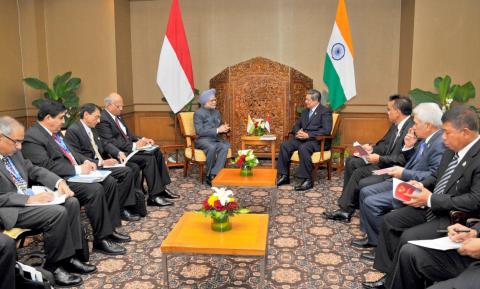Author: Thee Kian Wie, LIPI
India and Indonesia are two of Asia’s most resonant success stories: they are the continent’s third- and fifth-largest economies and are both members of the G20. But the story — and pace — of their success is considerably different.
In Indonesia, as Suharto began to rise to power in 1966 he inherited economic chaos, including hyperinflation of almost 600 per cent. Suharto responded by turning to a group of five economists from the University of Indonesia for economic advice, and began to implement a series of economic policies designed to restore macroeconomic stability and rehabilitate the economy.
The strategy worked: by 1969 price stability had been achieved and inflation reduced to 10 per cent. This set the stage for three decades of rapid, sustained GDP growth at an average annual rate of almost 7 per cent. This growth was accompanied by a steep reduction in the incidence of absolute poverty, which affected 40 per cent of the population at the beginning of Suharto’s tenure, and was as low as 11 per cent in 1996.
By the early 1990s per capita GNP had reached almost US$1000. Indonesia was no longer a low income economy and had graduated into the ranks of the lower middle income economies. By then, Indonesia had also decreased its traditional dependence on primary exports by rapidly increasing its manufactured exports, so that the World Bank’s East Asian Miracle report of 1993 classified it as a newly industrialising economy.
This was not to last. By late 1997 the serious financial and economic crisis that started in Thailand had engulfed all of Southeast Asia and South Korea, and caused Indonesia’s economy to go from miracle to melt-down. The Indonesian economy soon became dependent on the IMF and other donors for survival. The crisis caused the economy to contract by an unprecedented 13.1 per cent in 1998, and while in 1999 the economy recorded positive growth again, it was at a miniscule rate of 0.8 per cent. From then on, Indonesia has achieved positive growth. It reached a high of 6.5 per cent in 2011, but in 2012 growth is estimated to be only 6.1 per cent due to the uncertain outlook for the global economy and financial markets.
In contrast with the more open Indonesian economy, India had one of the most controlled economies outside the Communist bloc. This is no surprise considering that socialist ideology has been influential among India’s intelligentsia and policy makers over the past half century. India’s leftist leanings are pervasive, and even today the country seems unwilling to abandon its past dirigisme, which continues to block the necessary privatisation of its state enterprises.
After independence controls were imposed on prices, industrial investment, bank lending, the capital market, imports and even on some exports. The state retained ownership of several key industries, while a reservation scheme was introduced for small-scale enterprises. Domestic industry was heavily protected, competing imports were mostly banned, and the government restricted exports and foreign direct investment. Private monopolies were also restricted, which prompted many of India’s private companies to invest overseas, in both developing and developed countries. For their part, foreign multinationals have mostly been lured into joint ventures with India’s state-owned enterprises to service the large domestic market rather than export markets. As a result, in the first four decades of its independence India’s economy grew at an average annual rate of only 3 per cent, leading some foreign economists to quip that India’s was a ‘hindu rate of growth’.
Subsequently, from the late 1980s after Rajiv Gandhi became prime minister, some liberalisation measures and an expansionary fiscal policy were introduced. Economic growth accelerated, but by 1991 the fiscal reforms were revealed to be over-expansionary. Along with large-scale foreign borrowing, reduced worker remittances and higher oil prices due to the first Gulf War, these policies led to India’s most serious balance of payments crisis since the mid-1960s.
The then newly elected Narasimha Rao government, with Manmohan Singh as finance minister, responded to this crisis by embarking on an extensive program of liberalisation. This program has been remarkably successful. By the time the Rao government had to resign in 1996, quantitative controls on imports had been abolished, controls on foreign direct investment and controls on investment by the large private companies had been effectively phased out, and the public sector’s involvement in industrial activity was largely reduced. The financial sector was also liberalised and banking supervision strengthened.
The twist ending is that India introduced economic liberalisation measures more than 20 years later than Indonesia. Though they were implemented much later, these measures symbolised a decisive policy shift from statist nationalism to a liberal economic strategy. The outcome of that shift has been rapid economic growth and since the early 1990s India’s economy has grown at a pace second only to China. And even now, India’s growth rate continues to be higher than that of Indonesia.
While India has been growing at an average annual growth rate of almost 9 per cent during the past two decades, it could have grown faster and brought about a larger reduction in poverty if it had not pursued its dirigiste policy, but more liberal policies, which would have freed up the dynamism and creativity of its potential entrepreneurs.
While Indonesia grew at an average annual rate of almost 7 per cent during the three decades of Suharto’s authoritarian rule, it has since not been able to match this performance under more democratic governments. Sound economic policies, such as raising the highly subsidised price of petroleum, have often been stymied by populist policies encouraged by a newly-invigorated but corrupt parliament.
Thee Kian Wie is Senior Economist at the Economic Research Centre, Indonesian Institute of Sciences.
East Asia Forum
Cek berita, artikel, dan konten yang lain di Google News















